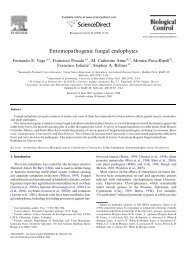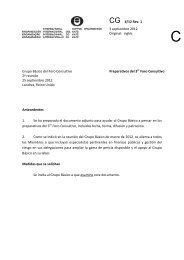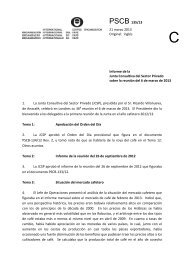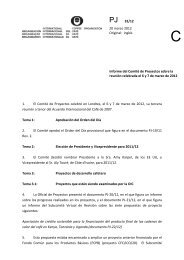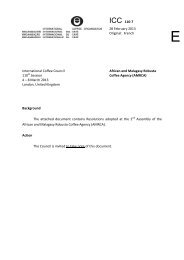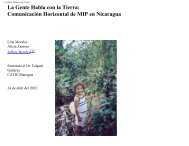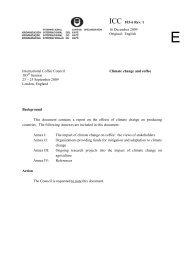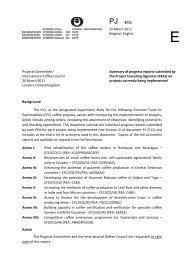Devouring profit - International Coffee Organization
Devouring profit - International Coffee Organization
Devouring profit - International Coffee Organization
You also want an ePaper? Increase the reach of your titles
YUMPU automatically turns print PDFs into web optimized ePapers that Google loves.
nity are not paying enough attention to their coffee crops. They felt that the state of<br />
the coffee business is so difficult that they are discouraged to invest time or money to<br />
improve productivity. They also cited the lack of organisation at the community level<br />
as a principal reason for lack of enterprise. However all of them were concerned about<br />
CBB; they considered that this pest is able to substantially reduce the out-turn (conversion<br />
rate) of coffee cherries to parchment coffee. Asked about the possible solution<br />
to the lack of interest, these farmers analysed all the factors they could think of<br />
and Table 10 summarises their deliberations.<br />
Thus from the farmers viewpoint, education is seen as the main path to self-motivation.<br />
Despite these difficulties, farmers were asked about CBB management before<br />
Table 10. Potential solutions to Chocola farmers’ lack of interest.<br />
and after the project started. They admitted that before the project began CBB management<br />
was non-existent. After the activities carried out by the project the situation<br />
had improved, at least for the farmers interviewed, because they were trying to adopt<br />
some of the proposed practices.<br />
Selling the coffee: there is frequently a long commodity chain for smallholder farmers<br />
in Guatemala. The first actor in the chain is the coffee producer who sells his coffee to<br />
an intermediary. There can be two or three intermediaries that buy coffee in different<br />
ways such as ripe cherries, parchment coffee or even green coffee. The longer the<br />
chain, the lower the price paid to the farmers. These intermediaries sell the coffee to<br />
the exporters who apply discounts according to quality.<br />
In the case of Chocola, the farmers could sell their coffee to the community organisation<br />
that was paying 58 Quetzals 6 /qq of cherries, but they preferred to sell to the<br />
intermediary who pays 60 Quetzals /qq, though some farmers had doubts about the<br />
reliability of the weighing machines used. Intermediaries also act as an informal bank<br />
because farmers borrow money from them. The amount they lend varies between<br />
3,000 and 8,000 Quetzals per farmer; sometimes as much as 15,000 Quetzals. The<br />
interest rate is very high, about 5% a month. But this credit facility leads many smallholders<br />
to sell their coffee to the intermediaries most of the time. Larger farms trade<br />
their coffee themselves, many of them are also exporters so this most likely makes<br />
them more aware of losses due to CBB. The quality problem is worth highlighting: the<br />
middlemen simply weigh the coffee and pay for it, ignoring the real quality. Hence<br />
there is no encouragement to improve quality of the coffee. This must negatively<br />
affect the efforts to encourage active CBB management.<br />
6 US$1=7.7 Quetzales (2000)<br />
27




